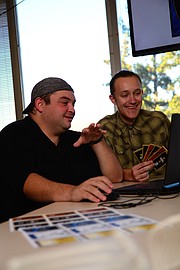Visualizing an ancient giant
Virtual tech students unravel mysteries behind mammoth bones
University of Idaho virtual technology and design students, including some from North Idaho, are bringing a set of mammoth bones to life through art.
Discovered in 1966, the approximately 11,700-year-old skeleton was found in Soda Springs, prompting the name for the skeleton: Cola.
The VTD class, Design Studio: Visual Mammoth, led by instructor Zeth DuBois, is consolidating data concerning the fossils and creating study tools for a real client, a University of Idaho geology course taught by instructor Renee Love.
DuBois designed the class to function similarly to a professional design studio by having the students work to meet a client’s needs.
DuBois said experience offered by this project provides students a glimpse into what the professional workplace is like, an opportunity that isn’t typically provided in an academic environment.
“I think this gives them time to think in really broad terms about big ideas,” DuBois said. “During the ideation phase, I’m encouraging them to just think of the craziest things they can think of and then subtract from there. I think it’s encouraging them to think outside the box and to work in a production pipeline.”
It is for this reason that junior VTD major Steven Frank, of Kellogg, decided to take the class.
“In professional studios, thousands of people can work on the same project,” Frank said. “We’ve got less than a dozen people. We have to rely on each other and everyone’s unique skillsets to complete each project. None of us could accomplish the projects alone.”
Junior VTD major Jesse Ross, of Rathdrum, serves as a project manager for the course, which is housed in the College of Art and Architecture.
DuBois offered Ross the role of project manager because he is able to organize communication between project groups, skills he gained through an associate degree focusing on communication and cultural issues.
Ross said the Design Studio class has taught him about responsibility in a team setting among other things.
“My work isn’t just about me and the grade I get anymore,” Ross said. “It’s about everybody’s grade. And beyond a grade, I want people to feel respected and to feel like the work that they’re doing matters.”
Modeling the Mammoth
The VTD students decided to focus on three different projects for the fall 2019 semester, decisions they made after consulting with Love and her students. The VTD projects will help the geology students visualize and communicate their research to each other and the public.
“We’re pushing the envelope on what we see as technology and access for educational purposes,” Frank said. “We’re trying to develop ways of helping people learn and understand.”
One group of students is creating a physical model of the dig site where Cola was found. The approximately 3-foot-by-3-foot relief map will integrate with an app the students will design. The app will allow users to point their phone at the model and view details about what the habitat and geology of the area would have been like when Cola was alive.
In addition, Frank and his teammates are designing a set of flashcards that inventory Cola’s bones. The cards will link to an online database that compares the bones to those of a complete mammoth fossil, named Plato, at the Smithsonian. The cards may also be made into an educational playing card game.
The last team is creating a set of small 3D-printed bones — one tenth the scale of the real mammoth — that will allow researchers and students to handle representations of the specimens with little risk of hurting the bones themselves.
They hope to create models of Cola and Plato.
Connection to Geology
All three projects are reliant on Love’s geology course, where students identify, measure and catalogue Cola’s bones. The bone data is recorded in an interactive database shared between the classes.
Frank said the VTD students are taking information from the geology course and applying it to the digital projects.
“That way, we can have interesting facts and information based on the bone, the digging site, the Plato design or why the bone is shaped the way it is,” Frank said. “We can make skeletons dance and move all we want, but we can’t give you the information the geology department can provide because they’re the ones who are studying the actual bones.”
Throughout the research, the design students have had the opportunity to see and touch some of Cola’s bones. In spring 2019, students from both courses visited Gritman Medical Center in Moscow, where the bones were put through a CT scanner. This supplied information about the dimensions and details of the bones through digital 3D models.
“When you’re holding those bones and you’re looking at them and you’re seeing the coloration and all the little nicks and imperfections, you understand that there’s so much information we have to get across,” Frank said.







